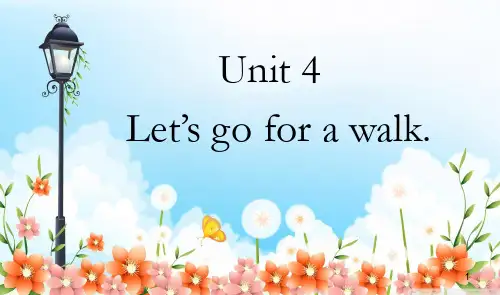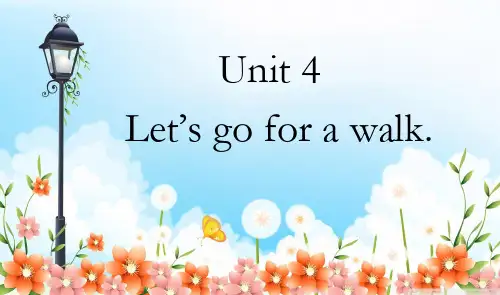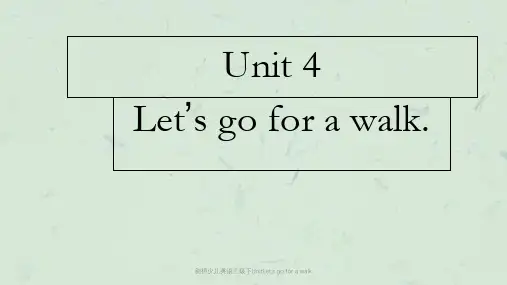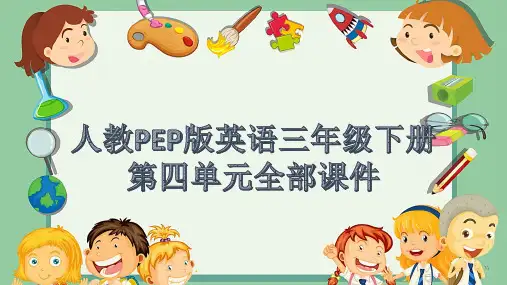剑桥少儿英语三级下Unit4Let;s_go_for_a_walk
- 格式:ppt
- 大小:2.58 MB
- 文档页数:25

Unit 4 Do you like pears? A Let’s talk of说课稿(英文版)Good morning, everyone! It's my great pleasure to be here sharing my teaching plan with you. Today I'm going to talk about Part A Let’s talk of Unit 4 Do You Like Pears in PEP Book 2.First, let me talk about the teaching material.The topic of this unit should be fruits. By study of this unit, Ss will be able to talk about likes and dislikes with the structures as Do you like …? Yes, I do./ No, I don’t. I like them very much. What about …? Let’s have some …The study will help Ss use simple English in communication. Second, teaching aims.1.Aims to the language knowledgea. After learning, Ss will be able to listen, speak and recognize the plural forms of the new words, such as pears, peaches, oranges and so on.b.Ss will be able to listen, speak and recognize the structures, such as Do you like …? Yes, I do./ No, I don’t. I like them very much. What about …? Let’s have some ….2.Aims to the language skills:a. Ss will be able to talk about likes and dislikes with the structures Do you like …? Yes, I do./ No, I don’t. I like them very much. What about …? Let’s have some ….b. Ss will learn to use English to gather and present information.3. Aims to the learning strategiesa. Ss will be familiar with the new words of fruits and the structures by cycling in the survey and other activities.b. Ss will be able to do a survey focus on their favor of fruits with the structures.4. Aims to the emotions:a. Ss have interests and motivation for their further English learning.b. Ss have positive communicative awareness.Third, key points.Ss will be able to understand and talk about likes and dislikes with the structures Do you like …? Yes, I do./ No, I don’t. I like them very much. What about …? Make sure that Ss can use the structure correctly and fluently.Fourth, difficult points.Ss can understand and say the plural forms of the new words.Fifth, teaching method.As we all know, the main instructional aims of learning English in primary school is to cultivate pupils’basic abilities of listening and speaking and their good sense of language. So in this lesson, I’ll mainly use “task-based”teaching method. That is to say, I’ll let the Ss learn in real situations, finish a task by making a survey to help the Ss to get a better understanding of the key structure of the dialogue. I’ll arrange many kinds of activities, like singing, guessing and so on. Sixth, learning methods.Let Ss study in a relaxed and agreeable atmosphere. Ss understand the new knowledge in certain degree through the mental process of seeing, hearing, saying, observing, imaging, thinking, etc. And make preperation for completing the new study task. After feeling and comprehending the language points, let Ss obtain the knowledge actively by cooperative study. Thereby, develop Ss’abilities of studying and working with the learning language independently.Seventh, teaching aids.I will use the multimedia player and a colourful picture of a fruit shop. And I’ll also make a lively PPT which can attract Ss’attentions very well.Eighth, teaching procedures and purposes of my designing.I’ll teach this lesson in 5 parts.Part I. Warm-upAs language can be learned gradually but not immediately, it’s important for the teacher to find out the links between the language learnt and the new language items. It can lead Ss into the new language items naturally. In this class, Ss will sing a song and take part in free talk with the teacher to recall their memories. Ss will be guided to understand the questions What colour do you like? Do you like …? What about …? and try to express their own favors of colours with the structures I like …Yes./ No.Part II. PresentationThe main purpose of this step is to present new language items. Usually we’d better put it under a real situation.In this class, I will use a big picture of a fruit shop, and show small parts of it. They are in different colours and can help Ss guess What’s in the picture? According to Ss’answer, the new words of fruits will be showed. And next, there will be a quick-response activity which focus on the new words. Then the whole picture will be showed. It will brings Ss into a situation In a fruit shop. I think the way of presentation can really arouse Ss’interests very well. And Ss will be able to understand and say the plural forms of the fruit words with the structures learnt in Unit 3 How many …can you see? I can see …. Guide Ss to pay more attention on their pronunciation. With the help of the lively picture, I will ask S what they like and if they like pears/…. While asking and answering, I will use expression, gesture to help present the target language Do you like …? What about …? and acts as a demonstrator. At that time, three facial expression cards will be presented. I will use to present Yes, I do. Use to present No, I don’t. Use to present Yeah, very much. When Ss have understood the structures, I will get the class to repeat it all together.After that, Amy and her mother will be introduced. Ss will try to find Amy’s likes and dislikes by listening to the tape of Let’s talk. According to Ss’feedback, I will show the class a copy of the questionnaire grid and fill in the blanks as a demonstration.FruitName pears peaches oranges watermelons applesAmyAnd next Ss will watch the video to understand the whole dialogue and learn to read the dialogue correctly. Then Ss will try to act out the dialogue in pairs.Part Ⅲ. PracticeThe main purpose of this step is to help Ss learn the language items by heart and make the language relevant, practical, and communicative.Task 1: Make a new dialogueHowever, as any children’s teacher will know, it is important for Ss to learn a lot more thanEnglish in their English classes. Not only for the intellectual but also the emotional development. So I will guide Ss to make a new dialogue between Amy and her mother. For example, Amy asks her mother: Mom, do you like …? What about …? Let’s have some …Task 2: Make a new chantWe have all experienced that music an rhythm make it much easier to imitate and remember language than words which are ‘just spoken’. So I will present a chant and guide Ss to make a new chant by themselves.For example:Do you likepeaches? Do you likepeaches?Yes, I do. Yes, I do. / Yeah, very much. Yeah, very much.Do you likeoranges? Do you like oranges?No, I don’t. No, I don’t.Task 2: Make a surveyAs we know, younger learners respond to language according to what it does or what they can do with it, rather than treating it as an intellectual game or abstract system. It is important to bear in mind that children need to see the reason for doing the activity, for example, to find information in order to make a survey. Give out copies of the questionnaire grid and guide Ss to ask their neighbours for information.FruitName pears peaches oranges watermelons applesLet’s havesome …Part Ⅳ. ConsolidationAs to this step, the main purpose is to consolidate what Ss have learned during the class and deal with the exercises of the workbook.Part Ⅴ. HomeworkIn order to extend Ss’ability of using English, I think it’s necessary to give Ss some good and proper homework. And according to Ss’level, it should be largely orally based. So I will ask Ss to do a family survey and try to use English as more as possible.Above is the lecture notes of my lesson. Thank you very much!。
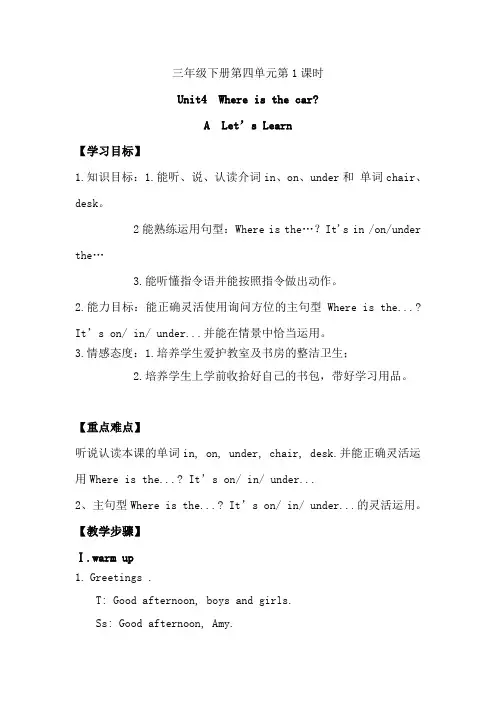
三年级下册第四单元第1课时Unit4 Where is the car?A Let’s Learn【学习目标】1.知识目标:1.能听、说、认读介词in、on、under和单词chair、desk。
2能熟练运用句型:Where is the…?It's in /on/under the…3.能听懂指令语并能按照指令做出动作。
2.能力目标:能正确灵活使用询问方位的主句型Where is the...? It’s on/ in/ under...并能在情景中恰当运用。
3.情感态度:1.培养学生爱护教室及书房的整洁卫生;2.培养学生上学前收拾好自己的书包,带好学习用品。
【重点难点】听说认读本课的单词in, on, under, chair, desk.并能正确灵活运用Where is the...? It’s on/ in/ under...2、主句型Where is the...? It’s on/ in/ under...的灵活运用。
【教学步骤】Ⅰ.warm up1.Greetings .T: Good afternoon, boys and girls.Ss: Good afternoon, Amy.T: How are you today?Ss: I’m fine, thank you.T: I’m fine too. It’s a great day, right? Work harder.And you are divided into 2 groups, Group A and Group B. If you do well, you can get a star, like this. Twinkle, twinkle , little star. So come on!T: Today we are gonna learn Unit 4 Where is my car?(此处教读car,发音渗透,c-ar, 动作展示开车的样子及声音,然后出示实物。
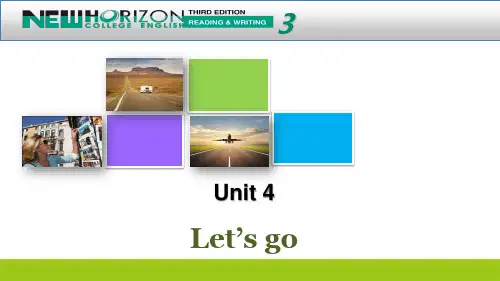
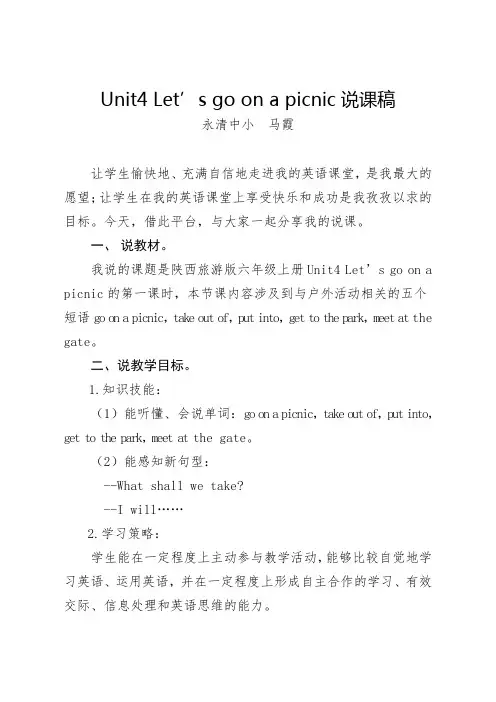
Unit4 Let’s go on a picnic说课稿永清中小马霞让学生愉快地、充满自信地走进我的英语课堂,是我最大的愿望;让学生在我的英语课堂上享受快乐和成功是我孜孜以求的目标。
今天,借此平台,与大家一起分享我的说课。
一、说教材。
我说的课题是陕西旅游版六年级上册Unit4 Let’s go on a picnic的第一课时,本节课内容涉及到与户外活动相关的五个短语go on a picnic,take out of,put into,get to the park,meet at the gate。
二、说教学目标。
1.知识技能:(1)能听懂、会说单词:go on a picnic,take out of,put into,get to the park,meet at the gate。
(2)能感知新句型:--What shall we take?--I will……2.学习策略:学生能在一定程度上主动参与教学活动,能够比较自觉地学习英语、运用英语,并在一定程度上形成自主合作的学习、有效交际、信息处理和英语思维的能力。
3.情感态度:从学生角度出发,培养学生合作共享的学习态度和竞争意识,使学生体验用英语进行交际的乐趣,激发学生主动参与的热情,并鼓励学生参与健康的户外活动,培养学生热爱生活、热爱大自然的美好情感。
三、教学重、难点:能听懂、会说词汇。
能感知新句型。
四、说教法、学法。
说教法。
为了顺利完成教学目标,更好地突出重点、突破难点,按照学生的认知规律,我采用了情境及情境假设法、交际法、游戏法等相互结合的方法,激发学生学习英语的兴趣,进而促使学生由兴趣发展到要学好它的志趣。
通过创设情境、游戏鼓励学生多开口。
说学法。
苏霍姆林斯基说过:“人的内心有一种根深蒂固的需要——总感到自己是一个发现者、研究者、探询者。
在儿童的精神世界中,这种需要特别强烈。
”在课堂中运用多种方法促使学生多听、多读、多说,形成自主、探究、竞争性学习,学生在互动交流的活动中建立自信,享受到学习的快乐,得到相关的知识,培养学生对英语运用的实践能力,让他们成为学习的主人。
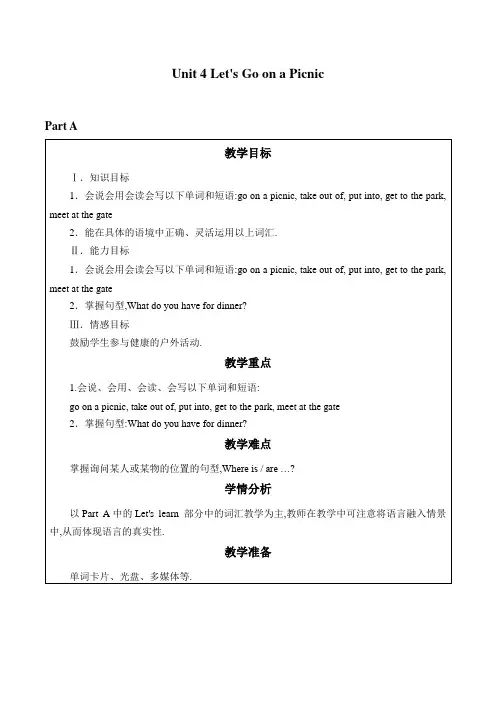
Unit 4 Let's Go on a PicnicPart A教学目标Ⅰ.知识目标1.会说会用会读会写以下单词和短语:go on a picnic, take out of, put into, get to the park, meet at the gate2.能在具体的语境中正确、灵活运用以上词汇.Ⅱ.能力目标1.会说会用会读会写以下单词和短语:go on a picnic, take out of, put into, get to the park, meet at the gate2.掌握句型,What do you have for dinner?Ⅲ.情感目标鼓励学生参与健康的户外活动.教学重点1.会说、会用、会读、会写以下单词和短语:go on a picnic, take out of, put into, get to the park, meet at the gate2.掌握句型:What do you have for dinner?教学难点掌握询问某人或某物的位置的句型,Where is / are …?学情分析以Part A中的Let's learn 部分中的词汇教学为主,教师在教学中可注意将语言融入情景中,从而体现语言的真实性.教学准备单词卡片、光盘、多媒体等.教学过程Ⅰ.热身导入:通过教师和同学们之间的对话来开始本课.T: What do you often do on weekends?Ss: I often … How about you?T: I usually …Ⅱ.新课展示:1.Look and circleWhat do you have for dinner?I have … for dinner.What's for dinner?I have … for dinner.2.Look and talkWhat do you often do on weekends?Watch TV at home. How about you?I usually go to the park and fly a kite.3.Let's learn学生看图,并且根据图片内容猜测汉语意思.go on a picnic 去野餐take out of 从……取出put into 放进……里面get to the park 到达公园meet at the gate 在大门口会合学生自己试读,然后听录音跟读,教师纠正发音.4.Let's talk教师出示课文挂图,让学生们仔细观察,并讨论图片内容.重点讲解以下内容:be free 空闲What's up? 怎么啦?at the foot of … 在……脚下Shall we meet at the gate of the park? 我们早公园大门口见面吗?come back 返回get to 到达听录音并跟读.分角色表演对话.Ⅲ.强化训练,当堂达标:1.复述课文.2.编造一个相似的对话.作业布置1.抄写“四会”短语各三行.2.预习下节课内容.板书设计Unit 4 Let's go on a picnicgo on a picnic 去野餐take out of 从……取出put into 放进……里面get to the park 到达公园meet at the gate 在大门口会合重点讲解以下内容:be free 空闲What's up? 怎么啦?at the foot of … 在……脚下Shall we meet at the gate of the park? 我们早公园大门口见面吗?come back 返回get to 到达Part B教学目标Ⅰ.知识目标1.能理解、听懂Let's learn more部分的对话.2.能可灵活运用shall和will表达将要做的事情.Ⅱ.能力目标1.能可灵活运用shall和will表达将要做的事情.2.理解shall在第一人称疑问句的结构中海还以表示提出建议征求意见的用法.Ⅲ.情感目标鼓励学生参与健康的户外活动.教学重点Let's learn more部分的对话.教学难点能可灵活运用shall和will表达将要做的事情.学情分析以Part A中的Let's talk部分中的会话为主要内容,通过在会话学习shall在第一人称疑问句中表示剃齿机安逸、征求意见的用法.教学准备单词卡片、教学挂图、资料包等.教学过程Ⅰ.热身导入:T: Today is a fine day. I want to go on a picnic.How about you?Ss: Me, too.T: Where shall we go?Ss: In the park or at the foot of the mountains.Ⅱ.新课展示:1.听录音、看图片理解课文意思.2.4—5人成立小组,分组讨论课文意思.3.教师随堂指导.4.根据课文内容回答问题.(1)What are the children doing?(2)Who is putting fruits into the water?(3)Is Alice hungry?(4)Would Su Tai like some chicken?(5)What will Colin do?5.重点讲解:child (复数)childrenat the foot / top of …Would like to …Shall we …?take a photo of …Ⅲ.强化训练,当堂达标:1.教师播放课文录音,学生听并且跟读.2.复述课文.Ⅳ.Ask and answer- I'm free tomorrow. What shall I do?- Will you/How about …?- I wouldn't like to do that.- What would you like to do?- I'd like to …- Have a good time.课堂检测好朋友,拉拉手.1.go on a picnic A.放入;放进……里面2 .take out of B.从……掏出3.put into C.去野餐4.meet at the gate D.在大门口汇合5.get to E.抵达作业布置学情分析综合复习本单元重难点的基础上,通过活动检测学生的学习效果.教学准备练习资料.教学过程Ⅰ.复习热身1.听写单词、短语和重点句子.2.背诵课文.Ⅱ.操练1.学生练习,合作探究.2.教师指点,互相评价.3.指导完成《配套练习》所剩内容.作业布置1.小组听写.2.背诵所学课文.3.预习下一课的单词和对话.课堂检测读句子,根据汉语提示补全对话.Wu Chen: I'm free ___________(明天)What shall I do? Aggie: Will you __________(打网球)?Wu Chen: No, I wouldn't like to do that.Toby: Then what would you like to do?Wu Chen: I'd like to _____________(拉小提琴).Toby: Great!____________________ (玩得开心点).连词成句.1.the, grapes, I, love (!)2.I, some, grapes, have (.)板书设计读句子,根据汉语提示补全对话.。

